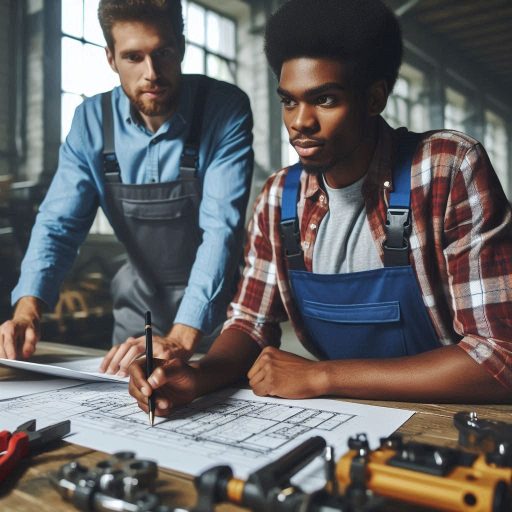Introduction
Brief Explanation of Industrial Design
Industrial design is the art and science of creating functional, aesthetically pleasing products.
Designers focus on improving usability and user experience.
They blend form and function to meet user needs.
Industrial design involves researching, prototyping, and refining products.
It influences everything from household items to high-tech gadgets.
This field integrates various disciplines, including engineering and ergonomics.
The goal is to create products that are both practical and visually appealing.
Designers consider materials, manufacturing processes, and sustainability in their work.
They aim to enhance the overall quality and appeal of products.
Importance of Industrial Design in Product Development
Industrial design plays a crucial role in product development.
It helps define a product’s look and functionality.
Effective design can differentiate a product in a competitive market.
It ensures that products are user-friendly and meet customer needs.
Good design improves the overall user experience and satisfaction.
It can also reduce production costs by optimizing manufacturing processes.
Designers address both aesthetic and practical aspects, leading to innovative solutions.
They create products that are not only attractive but also efficient.
Investing in industrial design can lead to better market acceptance and success.
Definition of industrial design
What Industrial Design Entails
Industrial design involves the creation and development of concepts for products intended for mass production.
It merges art, engineering, and business principles to address practical challenges and improve product functionality.
Industrial designers focus on enhancing the user experience through thoughtful integration of form and function.
This process includes studying user needs, generating innovative ideas, and developing prototypes.
Designers consider various aspects such as ergonomics, aesthetics, and materials to ensure that products are not only visually appealing but also easy and comfortable to use.
Industrial design also involves evaluating and selecting materials that contribute to the durability and cost-effectiveness of products.
The design process often requires collaboration with engineers and manufacturers to ensure feasibility and scalability.
Industrial designers must also anticipate and address potential manufacturing challenges, ensuring that their designs can be produced efficiently and economically.
This iterative process involves refining designs based on testing and feedback, ultimately leading to products that meet market demands and consumer expectations.
The Role of Industrial Designers in Creating Products
Industrial designers play a pivotal role in shaping the products we use every day.
Their process begins with researching user needs and preferences, which guides the design direction.
They create initial sketches and digital renderings to explore different ideas and concepts.
These designs are then turned into prototypes, allowing designers to test functionality, ergonomics, and aesthetics.
This iterative process of prototyping and testing helps to refine the product, addressing any issues before it moves to mass production.
Industrial designers focus on various aspects of a product’s development, including its form, usability, and the choice of materials.
They ensure that the product is both practical and visually appealing.
Their work includes considering the product’s environmental impact, user safety, and ease of use.
For example, they might design a kitchen appliance with intuitive controls and a sleek appearance, or a smartphone with an ergonomic shape and user-friendly interface.
Once a design is finalized, industrial designers collaborate closely with engineers and manufacturers to bring the product to market.
They provide detailed specifications and guidance to ensure that the design is accurately translated into the final product.
They also work on addressing any production challenges that may arise, such as optimizing the manufacturing process or selecting appropriate materials.
Beyond the design phase, industrial designers continuously gather and analyze user feedback to make necessary improvements.
They monitor market trends and technological advancements to keep their designs relevant and competitive.
By balancing aesthetics with functionality, industrial designers create products that enhance daily life and meet the evolving needs of consumers.
In summary, industrial design has a profound impact on everyday products by integrating form, function, and user experience.
Designers work through a detailed process to ensure that products are practical, attractive, and well-suited to their intended use.
Their role is crucial in shaping products that not only meet user needs but also contribute to a more enjoyable and efficient daily life.
Impact on product aesthetics
How Industrial Design Influences the Look and Feel of Products
Industrial design profoundly impacts the appearance and user experience of everyday products.
Designers focus on creating products that are not only visually appealing but also functional and comfortable.
The aesthetic elements, such as color, shape, and material, are carefully chosen to attract users and communicate the product’s purpose.
Industrial design goes beyond mere appearances; it shapes how a product feels in the user’s hands, considering factors like texture, weight, and ergonomics.
The process involves balancing form and function to ensure that products are both attractive and practical.
Designers consider how a product will be used and how it fits into the user’s lifestyle.
The design aims to enhance usability while making a strong visual statement.
By integrating aesthetics with functionality, industrial design ensures that products are enjoyable to use and visually pleasing.
Examples of Well-Designed Products That Stand Out Aesthetically
Several products demonstrate the impact of industrial design on aesthetics and functionality.
The Apple iPhone is a prime example of how industrial design can create a powerful visual impact.
Its sleek, minimalist design features a smooth glass surface and clean lines, setting a high standard for modern smartphones.
The iPhone’s design not only looks elegant but also feels intuitive and easy to use.
The Dyson Airblade hand dryer showcases how design can transform a simple product into an eye-catching and efficient device.
Its futuristic, streamlined appearance stands out in public restrooms.
The design complements its high-performance functionality, making hand drying both quick and hygienic while enhancing the user’s experience with its modern look.
The Herman Miller Aeron chair is another standout example of industrial design excellence.
Its ergonomic features, such as adjustable settings and mesh material, provide exceptional comfort and support.
The chair’s modern, distinctive look has made it an iconic piece of office furniture.
Its design not only addresses ergonomic needs but also contributes to a sophisticated office environment.
The Nest Learning Thermostat by Google combines smart technology with sleek design.
Its circular, minimalist form and intuitive interface make it both a stylish and functional addition to any home.
The thermostat learns from user behavior to optimize temperature settings, blending cutting-edge technology with a visually appealing design.
These examples illustrate how industrial design influences the look and feel of products, emphasizing the importance of both aesthetics and functionality.
Well-designed products not only stand out visually but also enhance the user experience by addressing practical needs and user comfort.
Through thoughtful design, products become more than just functional items—they become objects that delight users and make a lasting impression.
Read: Top Skills Needed for Art Educators and Instructors
Functionality and usability
How Industrial Design Improves the Functionality of Products
Industrial design plays a crucial role in enhancing product functionality.
Designers focus on creating products that are intuitive and efficient to use.
By understanding user needs, designers can streamline functions and improve usability.
Good design often involves simplifying complex tasks and making products more accessible.
For example, ergonomic designs ensure that products fit comfortably in users’ hands, reducing strain and enhancing ease of use.
Designers use principles of human factors engineering to optimize product interactions, such as adjusting the shape of handles or buttons for better grip and control.
Incorporating user feedback into the design process also improves functionality.
Designers conduct usability tests to identify and address issues before products reach the market.
This iterative approach ensures that products meet real-world needs and perform effectively.
Functional improvements might include adjusting dimensions, adding features, or redesigning components for better performance.
A well-designed product also considers efficiency and sustainability.
For instance, energy-efficient appliances reduce power consumption and environmental impact.
Industrial design integrates these considerations to create products that are both functional and eco-friendly.
Importance of Considering User Experience in Design
User experience is central to effective industrial design.
Designers prioritize how users interact with products, aiming to create positive and seamless experiences.
This focus on user experience ensures that products are not only functional but also enjoyable to use.
Designers conduct extensive research to understand user behaviors and preferences.
By gathering insights through surveys, interviews, and observations, designers can tailor products to better meet user needs.
This user-centered approach helps to create intuitive interfaces and enhance overall satisfaction.
Designing with user experience in mind also involves minimizing friction points.
Products should be easy to set up, operate, and maintain.
For example, simple controls and clear instructions contribute to a more pleasant user experience.
Reducing complexity helps users accomplish tasks more efficiently and with less frustration.
Another important aspect is accessibility.
Inclusive design ensures that products are usable by people with varying abilities.
Designers incorporate features such as adjustable settings or tactile feedback to accommodate diverse user needs.
Industrial design significantly impacts the functionality of everyday products by enhancing usability and efficiency.
Prioritizing user experience ensures that products are not only functional but also enjoyable and accessible.
This approach leads to more successful designs that meet user needs and improve daily interactions with products.
Read: Collaborating with Other Creative Roles
Innovation and creativity
How Industrial Design Fosters Innovation in Product Development
Industrial design drives innovation by integrating aesthetics, functionality, and user experience into product development.
Designers blend form and function to create solutions that solve real problems.
They analyze user needs and preferences to inform their designs, leading to innovative solutions that enhance usability.
By exploring new materials and technologies, industrial designers push the boundaries of what’s possible.
They often experiment with cutting-edge techniques to improve performance and user satisfaction.
This creative approach leads to the development of products that are both visually appealing and highly functional.
Designers also use research and prototyping to refine their ideas, ensuring that products meet high standards of quality and efficiency.
They collaborate with engineers, marketers, and manufacturers to integrate practical considerations into their designs.
This multidisciplinary approach fosters innovation by combining diverse expertise and perspectives.
As a result, industrial design not only improves existing products but also creates entirely new categories of products.
The focus on user-centered design ensures that innovations are relevant and beneficial to consumers.
Examples of Products That Showcase Creativity in Design
Several products exemplify the impact of innovative industrial design.
The Dyson Airblade hand dryer, for example, uses advanced technology to dry hands quickly and hygienically.
Its sleek, modern design also minimizes energy consumption and maximizes efficiency.
The Nest Thermostat is another example, combining user-friendly interfaces with smart technology.
Its intuitive design allows users to control their home’s temperature easily, while its learning capabilities adapt to user preferences.
The Tesla Model S showcases how industrial design can revolutionize transportation.
Its clean lines, high-performance features, and user-focused interfaces reflect a commitment to innovation.
The modular design of the IKEA KALLAX shelving unit illustrates how industrial design can provide flexible solutions for everyday needs.
Its simple, versatile design allows users to customize their storage solutions.
Another example is the Ooni Koda pizza oven, which integrates high-performance cooking technology into a compact, stylish design.
Its portability and ease of use demonstrate how industrial design can enhance outdoor cooking experiences.
These products highlight the role of industrial design in creating functional, aesthetically pleasing, and user-centric solutions.
Overall, industrial design fosters innovation by addressing user needs and pushing technological boundaries.
Creative designs like those seen in the Dyson Airblade, Nest Thermostat, Tesla Model S, IKEA KALLAX, and Ooni Koda pizza oven showcase how thoughtful design can transform everyday products.
By focusing on both form and function, industrial designers continue to drive progress and improve the way we interact with the world.
Read: Historic Costume Design Inspirations

Influence on consumer behavior
How Industrial Design Affects Consumer Choices
Industrial design significantly influences consumer choices.
A product’s aesthetic appeal and functionality directly impact its market success.
Consumers often base their purchasing decisions on the visual and tactile qualities of products.
Good design enhances usability and creates a positive user experience, making products more attractive.
Design elements like form, color, and texture play a crucial role in drawing consumers’ attention.
A sleek, modern design can make a product stand out in a crowded market.
Ergonomic features that improve comfort and ease of use also appeal to buyers.
For example, a well-designed kitchen gadget that feels comfortable in hand will likely be preferred over a less user-friendly option.
Moreover, industrial design addresses practical needs and solves problems, which can drive consumer preference.
Products that simplify tasks or offer innovative solutions often gain a competitive edge.
For instance, a vacuum cleaner with advanced filtration and a user-friendly design will attract buyers seeking efficiency and convenience.
Design also influences perceptions of quality and value.
A well-designed product can convey durability and high performance, leading consumers to view it as a worthwhile investment.
In contrast, poorly designed products might be perceived as less reliable or less valuable, impacting sales negatively.
The Role of Packaging and Branding in Product Design
Packaging and branding are integral to product design and significantly impact consumer perception.
Effective packaging not only protects the product but also enhances its appeal on store shelves.
Attractive packaging can attract attention and create a memorable first impression.
For instance, eco-friendly packaging often appeals to environmentally conscious consumers.
Branding plays a crucial role in distinguishing products from competitors.
Consistent and strong branding helps build recognition and trust.
A recognizable brand logo and design elements can influence consumer loyalty and repeat purchases.
High-quality branding communicates professionalism and reliability, which can sway buying decisions.
Additionally, packaging design can convey important information and differentiate product features.
Clear, well-organized packaging helps consumers understand what the product offers and how it can benefit them.
For example, detailed instructions and easy-to-read labels enhance usability and consumer confidence.
The design of packaging can also enhance the unboxing experience, adding emotional value.
A thoughtfully designed package that provides a pleasant unboxing experience can increase consumer satisfaction and encourage sharing on social media.
This, in turn, can drive word-of-mouth marketing and attract new customers.
In fact, industrial design profoundly affects consumer choices by influencing product appeal, functionality, and perceived value.
Packaging and branding further enhance this impact by providing visual appeal and communicating key product attributes.
Together, these design elements play a crucial role in shaping consumer preferences and driving market success.
Read: Breaking Down Iconic Movie Costumes
Sustainability and environmental impact
Examining How Industrial Design Can Contribute to Sustainability Efforts
Industrial design plays a crucial role in advancing sustainability.
Designers now prioritize eco-friendly materials and processes.
They focus on reducing waste and energy consumption.
By selecting sustainable materials, designers contribute to lower environmental impact.
For instance, companies are adopting recycled materials in product design.
Recycled plastics and metals reduce the demand for virgin resources.
This practice helps conserve natural resources and decrease pollution.
Designers are also creating modular products, which can be easily repaired or upgraded.
Modular design extends the life cycle of products and reduces waste.
Designers also consider the end-of-life phase of products.
They aim for products that are easy to disassemble and recycle.
This approach simplifies the recycling process and minimizes landfill waste.
By designing with the entire product life cycle in mind, designers promote a circular economy.
Moreover, industrial design can enhance energy efficiency.
Designers are integrating energy-saving technologies into products.
For example, LED lighting and energy-efficient appliances are now common.
These innovations reduce energy consumption and lower carbon footprints.
Highlighting the Importance of Eco-Friendly Design Practices
Eco-friendly design practices are essential for a sustainable future.
Designers must consider the environmental impact of every decision.
Choosing non-toxic, biodegradable materials reduces harmful emissions and waste.
Designers should prioritize materials with a lower environmental footprint.
Designers are increasingly using life cycle assessments to evaluate environmental impacts.
This tool helps them understand the ecological effects of their designs from production to disposal.
Such assessments guide designers in making more sustainable choices.
Another important practice is reducing product packaging.
Minimalist packaging reduces waste and lowers transportation costs.
Eco-friendly packaging materials, like biodegradable plastics, further decrease environmental impact.
Designers must also focus on product durability and longevity.
Designing products that withstand wear and tear reduces the need for frequent replacements.
High-quality, durable products have a longer life cycle and less environmental impact.
Incorporating user education into design can also drive sustainability.
Informing users about proper disposal and recycling practices encourages responsible behavior.
Designers can create products with clear instructions for recycling or composting.
In review, industrial design significantly impacts sustainability.
By adopting eco-friendly practices and prioritizing sustainable materials, designers contribute to environmental preservation.
Their efforts in creating durable, energy-efficient products and minimizing waste lead to a more sustainable future.
As designers continue to innovate, their commitment to eco-friendly practices will shape the future of industrial design.
Conclusion
Industrial design revolutionizes everyday products by combining functionality with aesthetics.
Designers focus on meeting user needs and reducing environmental impact.
They thoughtfully select materials and incorporate technology to enhance performance and usability.
Innovations such as smart appliances and eco-friendly packaging showcase these principles.
For example, a sleek smartphone not only looks modern but also integrates advanced features for better user experience.
Similarly, energy-efficient home appliances reflect a commitment to sustainability, using less power while delivering superior performance.
The impact of industrial design extends beyond mere aesthetics.
It shapes how we interact with and experience products.
Ergonomic designs, for instance, reduce physical strain and increase comfort during use, which is particularly important for tools and furniture.
Eco-conscious designs help mitigate environmental harm by promoting recycling and using sustainable materials.
The result is a range of products that not only look good but also contribute positively to our daily lives and the planet.
Industrial design plays a pivotal role in transforming ordinary items into innovative solutions.
Its influence is evident in the improved functionality, enhanced user experience, and environmental benefits seen in the products we use every day.
[E-Books for Sale]
The Big Book of 500 High-Paying Jobs in America: Unlock Your Earning Potential
$19.99 • 500 High-Paying Jobs • 330 pages
Explore 500 high-paying jobs in America and learn how to boost your career, earn more, and achieve success!
See All 500 High-Paying Jobs of this E-Book
1001 Professions Without a Degree: High-Paying American Jobs You Can Start Now
$19.99 • 1001 Professions Without a Degree • 174 pages
Discover 1001 high-paying jobs without a degree! Unlock career tips, skills, and success strategies for just $19.99!




